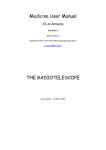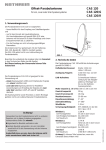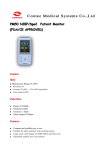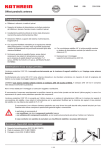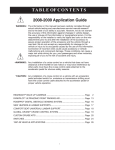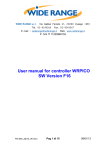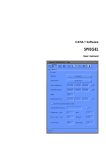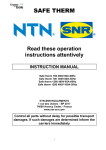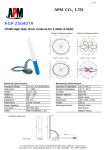Download Noto User Manual THE RADIOTELESCOPE
Transcript
Noto User Manual 32-m Antenna Version 1 Elena Cenacchi, Alessandro Orfei, Francesco Schillirò, Karl-Heinz Mack [email protected] THE RADIOTELESCOPE Last update : 11 September 2006 2 3 Index 1 – INTRODUCTION............................................................................................ 5 2 – ANTENNA STRUCTURE .................................................................................. 2.1 Primary reflector......................................................................................... 2.2 Quadrupod and secondary reflector ............................................................... 2.3.1 Wobbling ........................................................................................... 2.3 Pointing errors ........................................................................................... 2.4 Specification summary ................................................................................ 2.4.1 Observation conditions......................................................................... 2.4.2 Surface accuracy................................................................................. 2.4.3 Pointing errors .................................................................................... 7 7 8 9 10 11 11 11 12 3 – OPTICS......................................................................................................... 3.1 Primary focus ............................................................................................. 3.2 Cassegrain focus......................................................................................... 3.3 Servosystems specifications ......................................................................... 13 13 14 15 4 – FRONT END .................................................................................................. 4.1 Feeds and receivers .................................................................................... 1.6 GHz ..................................................................................................... 2.3/8.3 GHz................................................................................................ 5 GHz ........................................................................................................ 22 GHz ...................................................................................................... 43 GHz ...................................................................................................... 4.2 Distributions .............................................................................................. 4.3 Control room.............................................................................................. 17 17 18 19 20 21 22 23 24 5 – EFFICIENCY AND SYSTEM TEMPERATURE ..................................................... 25 6 – VLBI ............................................................................................................. 27 7 – OBSERVING MODES ...................................................................................... . 29 7.1 ON-OFF techniques ..................................................................................... 29 7.2 Mapping techniques .................................................................................... 29 8 – BACK END..................................................................................................... . 8.1 Spectrometers............................................................................................ 8.1.1 Arcos................................................................................................. 8.2 Continuum................................................................................................. 8.2.1 Mark IV ............................................................................................. 8.3 VLBI ......................................................................................................... 8.3.1 Mark IV ............................................................................................. 33 34 34 35 35 37 37 4 5 1. Introduction The Noto 32 m antenna is a Cassegrain radiotelescope operated since 1989, by the Istituto di Radioastronomia, until 2004 part of the CNR (Consiglio Nazionale delle Ricerche) and now part of the INAF (Istituto Nazionale di AstroFisica). Fig. 1.1 : The Noto antenna The main features of this instrument are the following : • • • Active surface Secondary reflector wobbling (shifting time ≤ 1 sec at ν ≥ 20 GHz) Complete automation and remote control of the observing settings 6 Position Noto, Italy Coordinates Lat. 36°52'33.78" N - Long. 14°59'20.51" E Alt. 30 m f.s.l. Optics Cassegrain Frequency coverage 1.4 ÷ 86 GHz Primary reflector diameter 32 m Secondary reflector diameter 3.2 m Available foci Primary f/D = 0.32 Cassegrain f/D = 3.04 Elevation range 0°÷90° Azimut range ± 270° Slew rates (wind speed < 60 km/h) 48°/min Azimuth 30°/min Elevation Surface accuracy (rms specified) 0.1 mm Pointing accuracy (rms specified) 8 arcsec FWHM Beamwidth 38.7 arcmin/f (GHz) Gain 0.10 ÷ 0.16 K/Jy First secondary lobes circa 20 dB under the main lobe Receivers mounts Primary Focus : movable positioner (2 receiver bays) Cassegrain Focus : fixed (1 receiver bay) Parabolic reflector correction system Active surface (Look-up table) Tab. 1.1 : Characteristics of the Noto antenna Fig. 1.2 : The Noto antenna, side 7 2. Antenna Structure 2.1 Primary Reflector The primary reflector. diameter 32 m, is made of 240 aluminium panels (RMS = 0.4 mm) substained by a backup reticular truss. The housing of the Cassegrain focus feeds is at the mirror vertex. Fig. 2.3 : Primary reflector, front C1 (mm) D1 (mm) D2 (mm) Raw B 2617.8 437.62 1113.96 Raw C 2604.15 1113.96 1770.4 Raw D 2617.24 887.1 1206.06 Raw E 2648.38 1206 1515 Raw F 2659.33 1515.04 1810.74 Raw G 2718 1810.74 2098.14 Tab 2.1 : Geometry of the panels 8 2.2 Quadrupod and Secondary Reflector The primary reflector backup structure substains the secondary mirror, placed at a distance of 9 m, through 4x45° inclined beams (quadrupod). The secondary mirror is a hyperbolic reflector, 3.2 m diameter, made of a single aluminium panel (rms = 0.35 mm). On the backup structure 3 mechanical actuators are installed and allow the mirror to tilt around the 3 axes. In addition the whole system can translate along the x and y axis. Fig. 2.4 : Hyperbolic mirror The mirror must completely be retracted along the y axis when the primary focus is used. Fig. 2.5 : Configuration for Cassegrain focus usage (plain line) and primary focus usage (dotted line) The mirror and the quadrupod induce an obstruction on the primary reflector of nearly 4%. Cause Obstruction Sub-reflector 2% Quadrupod 2% Total 4% Tab. 2.2 : Primary reflector obstruction 9 2.2.1 Wobbling The system that rotates the secondary mirror has been optimized in order to enhance the number of receivers that can be installed at the Cassegrain focus , but actually it is used only to realize the "Wobbling" technique, using one receiver at once. Typical shifting times, shorter then those used in Position Switching, are listed in the following table. Frequency Beam HPBW (GHz) (“) Mirror rotation Mirror rotation Required time Required time 2.5 beam 5 beam (sec) (sec) (°) (°) 5 450 2.56 1.16 5.12 2.12 6 390 2.22 1.03 4.44 1.86 22 120 0.68 0.45 1.37 0.71 Tab. 2.3 : Wobbling time for 2.5-beam and 5-beam throws 2.3 Pointing Errors The accuracy of the pointing correction increases with the observing frequency, i.e. as the antenna beam width decreases. Commonly the following is assumed : δp = HPBW 10 δp = pointing accuracy HPBW = -3 dB beam width (main lobe) For the Noto antenna the values are listed in the following : Frequency HPBW Error (GHz) (') (') 1.5 29 ≤ 2.9 22 2 ≤ 0.2 Tab. 2.4 : Beam and pointing errors The systematic errors are usually quite high (some arcminute). Anyway they have been determined according to the antenna position (Az/El) after apposite astronomical observations (reference radio sources), and a correction model has been derived. Once the model has been applied, the residual error is 0.1' (both in azimuth and elevation), exactly as required. 10 2.4 Specification Summary 2.4.1 Observation conditions Parameters Precision Normal Survival Specifications Wind, continuous Wind, gusts < 25 km/h 20÷ 30 km/h Sun Absent Precipitation Absent Temperature -25 ÷ 30 °C Humidity < 90 % Wind, continuous Wind, gusts < 65 km/h 50 ÷ 80 km/h Precipitation Absent Temperature -30 ÷ 50 °C Humidity < 100% Wind 200 km/h Precipitation < 5 cm/h snow Seismic 0.3 g horizontal Tab. 2.5 : Observation conditions In survival conditions, and when not in use, the antenna must be settled at 90° elevation and 206.151° azimuth (stow position). 2.4.2 Surface Accuracy (RSS mm) (RSS mm) 90° El 60° El Structural Elements Primary reflector panels 0.1 0.1 Secondary reflector panels 0.38 0.38 Gravitational deformation 0 0 0.2 0.2 Total surface accuracy Tab. 2.6 : Surface accuracy at 90° and 60° elevation To estimate the phase error ε from the surface accuracy, the following can be used : ε = δ = surface accuracy λ = observation wavelength 4πδ λ [rad] 11 Usually a maximum tolerable phase error is assumed as ε≈36°≈0.63 rad , so that the minimum observable wavelength is λmin ≈ 20δ max This means for the Noto antenna : λ min ≈ 4 mm → ν max ≈ 75 GHz 2.4.3 Pointing accuracy Observation condition Pointing accuracy (rms arcmin) Normal/Precision 0.13 Tab. 2.7 : Pointing accuracy 12 3. Optics The Noto antenna has 2 focal positions : • • Primary focus : F1 Cassegrain focus : F2 Fig. 3.1 : Optics of Noto antenna [dimensions : mm] 3.1 Primary Focus With the Cassegrain optics the primary reflector focus is usable only if the secondary reflector is completely retracted. Behind the mirror a movable positioner is installed, equipped with 3 receiver bays. Fig. 3.2 : Primary focus feed positioner 13 The primary mirrror focal length is nearly 10.3 m, therefore the focal ratio is F1/D ≈ 0.32. Fig. 3.3 : Primary focus (dimensions : mm) 3.2 Cassegrain Focus The secondary mirror (9 m from the primary mirror) allows the usage of the Cassegrain focus (at nearly 20 cm above the reflector vertex) This focus has been designed to offer several adjacent focal positions, which can be obtained through the angular movement of the secondary mirror (see fig. 3.4). Fig. 3.4 : Cassegrain focal plane Unlike the Medicina antenna, the focal positions do not host different receivers and the frequency change requires the installation of the necessary receiver into the central bay. The 14 Wobbling technique is used only to realize the Beam Switching (e.g. On Source-Off Source) and to carry faster radiometric measurements. The secondary hyperbolic reflector yelds a magnification i2 which depends on the ratio between the focal length and the distance from the prime focus (nearly 9 m and 1 m, respectively). The total focal length can be estimated as follows : 9.074 ≈ 9.49 0.956 F2 = i 2 ⋅ F1 ≈ 97.36 [m] i2 = The focal ratio is therefore: F2 / D ≈ 3.04 3.3 Servosystems Specifications Azimuth drive Angular travel Kinematics Angular velocity Angular acceleration Configuration Track Unity Value (°) 540 (°/sec) 2 0.8 (°/sec ) 0.82 Number of wheels (-) 4 Driving wheels (-) 2 Drives per wheel (-) 1 Diameter (m) 18.3 Unity Value (°) 90 Tab. 3.1 : Azimuth drive Elevation drive Angular travel Kinematics Angular velocity Angular acceleration (°/sec) 0.5 2 (°/sec ) 0.31 Unity Value (mm) 420 Tab. 3.2 : Elevation Drive Primary focus feed positioner Linear travel Kinematics Linear velocity Linear acceleration (mm/sec) 2 (mm/sec ) Tab. 3.3 : Primary focus feed positioner, transverse axis 7.2 24 15 Primary focus feed positioner z axis Linear travel Kinematics Linear velocity Linear acceleration Unity Value (mm) 350 (mm/sec) 2 (mm/sec ) 7.2 24 Tab. 3.4 : Primary focus feed positioner, z axis Sub-reflector Kinematics Unity Value Linear travel x axis (mm) 160 Linear travel y axis (mm) 160 Linear travel y axis out of focus (mm) 2240 Linear travel z axis (mm) 250 Angular travel x axis (°) ±4.2* Angular travel y axis (°) ±4.2* Linear velocity x axis (mm/sec) 55.5 Linear velocity y axis (mm/sec) 17.1 Linear velocity z axis (mm/sec) 48.3 (°/sec) 1.9 Angular velocity Tab. 3.5 : Sub-reflector kinematics 16 17 4. Front End 4.1 Feeds and Receivers The Noto antenna covers the range 1.35÷48 GHz. The following receivers are available : Band ν0 λ νLsky νHsky Channels (Label) (GHz) (cm) (GHz) (GHz) P UHF 0.327 92 0.5-1 60-30 L+R 0.317 0.332 Gain K/Jy 0.1 Noise Bandwidth Temperature (MHz) (K) 150 HPBW Hemt Cooled - 100’ N N L+R 0.5 1 0.1 - - 32’-64’ N N L 1.6 18/21 L+R 1.40 1.72 0.12 120 2x35 22’ Y N S 2.3 13 R 2.2 2.36 0.17 120 2x160 20’ Y N C 5 6 L+R 4.7 5.05 0.15 30 2x350 8’ Y Y X 8.3 3.6 R 8.18 8.58 0.15 110 2x400 4.8’ Y N 12 12 2.5 HV 11.70 12.75 - - - 3’ N N K 22 1.3 L+R 22.18 22.46 0.13 90 2x400 1.7’ Y Y Q 43 0.7 L+R 38 48 0.1 70 2x400 0.9’ Y Y Tab. 4.2 : Receivers parameters Primary Focus Cassegrain Focus νLsky ÷ νHsky : receiver maximum bandwidth The receiver labels have been assigned only for identification purpose. At UHF, P, L, S bands the effective bandwidths can be smaller due to RFI. 18 1.6 GHz Type Channels Polarization Hot 2 LHC-RHC Central frequency (GHz) 1.56 Noise temperature (K) 120 Useful RF band (GHz) 1.40÷1.72 RF filter width (MHz) 320 IF filter width (MHz) 35 Instantaneous RF band (GHz) 1.366÷1.446 LO frequency (GHz) 1.279 LO range (GHz) 1.020÷1.305 Conversion (GHz) Single USB 0.330÷0.365 Standard parameters of the 1.5 GHz parameters The maximum bandwidth is 80 MHz, tunable only within the two RF ranges listed in the above table. To shift the IF standard band inside the RF band of Δν, the LO frequency must be changed (within the range listed in the table) according to the following : RF = 1.4 ÷ 1.72 → ν OL = 1.279 ± Δν 19 2.3-8.3 GHz Type Hot Coaxial Channels Polarization 2 LHC-RHC LHC-RHC Central frequency (GHz) 2.28 8.58 Noise temperature 120 110 Useful RF band (GHz) 2.20÷2.36 8.18÷8.58 RF filter width (MHz) 160 400 IF filter width (MHz) 160 400 Instantaneous RF band (GHz) 2.20÷2.36 8.18÷8.58 LO frequency (GHz) LO range (GHz) Conversion (GHz) 2.020 8.080 0 0 Single USB Single USB 0.18÷0.34 0.1÷0.5 Standard parameters of the 2.3-8.3 GHz coaxial receiver It is possible to use the receivers both together (coaxial, 2 IF outputs, one per each frequency) and separately (2 IF outputs). For the VLBI coaxial observation one channel only for each receiver is used, typically the right hand circular polarized one (this because the Mark IV can handle only 2 IF inputs). 20 5 GHz Type Cooled Channels 2 Polarization LHC-RHC Central frequency (GHz) Noise temperature 4.875 30 Useful RF band (GHz) 4.65÷5.15 RF filter width (MHz) 500 IF filter width (MHz) 350 Instantaneous RF band (GHz) 4.700÷5.050 LO frequency (GHz) LO range (GHz) 1.150x4 1.138÷1.175 Single USB 0.1÷0.45 Conversion (GHz) Standard parameters of the 5 GHz receiver To shift the IF standard band inside the RF band of Δν, the LO frequency must be changed (within the range listed in the table) according to the following : ν OL = 4.600 ± Δν 4 21 22 GHz Type Cooled Channels 2 Polarization LHC-RHC Central frequency (GHz) 22.150 Noise temperature (K) 90 Useful RF band (GHz) 21.90÷22.40 RF filter width (MHz) 500 IF filter width (MHz) 400 Instantaneous RF band (GHz) 21.95÷22.35 LO1 frequency (GHz) 1.150 x18 LO2 frequency (GHz) 1.150 LO1 range (GHz) 20.668÷20.778 Conversion (GHz) Double USB 1.147÷1.153 0.1÷0.5 Standard parameters of the 22 GHz receiver To shift the IF standard band inside the RF band of Δν, the LO frequency must be changed (within the range listed in the table) according to the following : ν OL = 22.15 ± Δν − 0.3 19 22 43 GHz Type Cooled Channels 2 Polarization LHC-RHC Central frequency (GHz) 42.5 Noise temperature (K) 40 Useful RF band (GHz) 37÷48 RF filter width (MHz) 11000 IF filter width (MHz) 400 Instantaneous RF band (GHz) LO1 frequency (GHz) LO1 range (GHz) LO2 frequency (GHz) Conversion 42.3÷42.7 15.86 13.21÷18.51 10.500 Double USB 10.5÷11.5 0.1÷0.5 Standard parameters of the 43 GHz receiver To shift the IF standard band inside the RF band of Δν, the LO frequency must be changed (within the range listed in the table) according to the following : ν OL = 42.5 ± Δν − 10.5 − 0.271 2 23 4.2 Distribution The connections between the radiotelescope foci involve three different kinds of signal : . Local Oscillator : in order to cut down the expenses related to the construction of a high number of independent superheterodyne receivers, a common solution is to share some local oscillators (at least for one conversion). A single local oscillator therefore can serve more receivers through a signal distribution system. . IF : the RF signals, once received and converted by the Front End, are sent to the Back End installed in the Control Room, at the antenna base. . Reference : 5-MHz H-maser signal, necessary for the local oscillator stability. All the signals are distributed via coaxial cable. The distribution scheme is simplified by the fact that there are only two double-conversion receivers (6 GHz at the Cassegrain focus and 22 GHz at the primary focus). Both use the same local oscillator for the second conversion. Besides the two receiver channels cannot be tuned at different positions inside the RF bandwidth. The LO signal is distributed by an LO distributor (OLD). The reference distributor (REFD) and the IF distributor (IFD) are also installed in the Cassegrain focus. The receiver can be chosen from the Control Room using the selector. Fig. 4.2 : Signal distribution between the foci 24 4.3 Control Room The backend systems are installed in the control room, located at the antenna's base. It is connected to the foci through the links shown in the following (red line and green line are fiber optic links) : Fig. 4.3 : Control links From the control room receivers, antenna and sub-reflector movement can be controlled. Moreover the new metrology system (temperature sensors) and a little antenna used for the olographic measurement of the surface can be operated. 25 5. Efficiency and System Temperature The antenna gain is defined as : G = 10 −26 mη A Ag ⎡K ⎤ ⎢ ⎥ ⎣ Jy ⎦ kB m = 0.5 (non polarized radiation) Ag = geometric area kB = Boltzmann's constant ηA = antenna efficiency For the Noto antenna, the constants are : 10 −26 Ag 2 ⋅ kB ≈ 0.292 ηA is the overall efficiency, estimated assembling all the signal degradation factors. The antenna gain varies according to the elevation and it reaches a maximum at 45°. A good interpolation is obtained with a second degree polynomial, such as : ax 2 + bx + c The coefficients of the normalized polynomials, at each frequency, are listed in the following : Frequency (GHz) a b c 0.327 0 0 1 0.5-1 0 0 -5 1 -3 7.285044·10 8.0577027·10-1 1.6 -6.8310687·10 2.3 -5.8197959·10-5 9.4270958·10-3 6.1824204·10-1 5 -1.4396956·10-5 1.9594323·10-3 9.3333009·10-1 8.3 -6.2013643·10-5 6.9932510·10-3 8.0284355·10-1 12 -1.1407653·10-4 1.1413276·10-2 7.1452747·10-1 22 -2.0746800·10-5 1.7584500·10-3 2.0928100·10-2 Tab. 5.1 : Normalized gain curves, coefficients 26 The sensitivity can be estimated as follows : ΔS = αT sys G Δν τ nN IF = receiver constant (=1) Tsys = system temperature G = gain (K/Jy) Δν = bandwidth τ = integration time n = integration number NIF = available channels (= 1,2) In the following table the system temperatures and the sensitivities of the Medicina antenna are listed : ν0 (GHz) T receive (K) Tsys (K) ηA (%) G (K/Jy) SEFD (Jy) Bandwidth (MHz) 0.327 150 170 34 0.1 1700 2x15* 310 0.5-1 - - 34 0.1 - - - 1.6 120 130 41 0.12 1083 2x35* 129 2.3 120 140 58 0.17 823 2x160* 46 5 30 48 51 0.15 320 2x350 12 8.3 110 130 51 0.15 867 2x400 31 12 - - - - - 2x1050 - 22 90 110 44 0.13 846 2x400 30 43 70 80 28 0.1 800 2x400 21 Tab. 5.2 : Sensitivity of the antenna, assuming τ = 1 sec, n=1, NIF = 2 Primary Focus Cassegrain Focus *Usually at these frequencies a narrower bandwidth is used because of RFI. 27 6. VLBI Regarding the VLBI observations, the Noto antenna is part of the EVN (European VLBI Network) since 1984. Some observations have been conducted using only the two Italian antennas (Noto and Medicina) and the Bonn correlator. 28 29 7. Observing Modes 7.1 ON-OFF Techniques In order to reduce as much as possible the atmospheric contribution during an observation, it is possible to apply some techniques based on at least a couple of exposures, one on source and one on an adjacent area ("OFF source" reference position), sufficiently free from emission. At high frequencies short-scale and strong atmospheric fluctuations affect the observation, hence the need of quick antenna shifts between the two positions (which have to be reasonably close to each other) or the usage of other techniques which do not involve the movement of the entire structure. The Noto antenna offers the following ON-OFF techniques : . Position Switching The antenna shifts between two different positions. The time needed to cover some beams is nearly 5 seconds at all frequencies. . Wobbling The shifting of the beam is obtained moving the secondary mirror only. This technique requires always a shorter time than the Position Switching. In both cases the algorithm used is of the type ON-OFF-ON-OFF. 7.2 Mapping Techniques If the radio emission is extended over an area larger than the antenna beam, several pointings might be necessary in order to cover the entire area of interest. The Nyquist theorem states that the correct source sampling along a direction requires an angular distance between the pointings of : Δϑ = 1λ 2D The Nyquist sampling is commonly expressed as fraction of the beam : Δϑ = 1λ ≈ 0.43HPBW 2D 30 The Noto antenna mainly offers two mapping techniques : . Raster Scan The map is obtained through discrete adjacent pointings ("point and shoot" mode). At every step the antenna stops and acquires data for the exposure time required. The time necessary to cover an area A, considering the on-source time only, with a monofeed system, can be roughly estimated as : t ON ≈ N p ⋅ t esp Np = A (HPBW 2) 2 Np = number of pointings tesp = single exposure time (depending on the sensitivity required). The Nyquist sampling is approximated with a half-beam shift in both directions (vertical and horizontal). Usually this mapping technique is associated with an ON-OFF technique, therefore the total time necessary to complete a survey is given by : t TOT = t ON + t OFF + t sh t OFF = N P ⋅ t esp = t ON tsh = antenna shifting time (Position Swiching) or secondary mirror shifting time (Wobbling) The scan can be conducted in several user-defined ways, the most common is along two perpendicular directions ("cross scan"). . On-The-Fly In the "On-The-Fly" mode the antenna is moved along one direction, usually with a "rawsand-columns" path, at constant speed. The data are continously acquired and downloaded by the backend every few seconds ("OTF dumps"), corresponding to angular excursions of few arcseconds (depending on the antenna speed). To reach the required sensitivity it is necessary to scan the same area several times, preferably along different directions. The ON-source time is : t ON = N d ⋅ t d td = acquisition time Nd = number of dumps (depending on the required sensitivity). The Nyquist sampling is obtained if the acquisition time, for each dump, corresponds to an angular antenna shift equal or shorter than the ideal Nyquist distance. Also the distance between raws and columns must be coherent with the Nyquist sampling. 31 The On-The-Fly technique is characterized by very short scanning times, so it is the best one in order to reduce the atmospheric contribution (anyway it is necessary to use an ON-OFF technique). For a squared spectroscopic map the total observing time can be estimated with the following : t ON = t ON + t OFF t OFF = N d ⋅ t ON The Noto antenna offers the On-The-Fly Mapping on a user-defined RA/Dec map, with a maximum scan speed of 200 "/s. 32 33 8. Back End The Noto antenna is equipped with the following processing systems : • ARCOS Autocorrelator Input 2 Maximum bandwidth per input 16 MHz Minimum bandwidth per input 0.125 MHz* Channels 2048 A/D Conversion 2 bit Available software ADLB4 Tab. 8.1 *Can be further reduced on request • Total Power Input 3 Maximum bandwidth per input 400 MHz A/D Conversion 16 bit Available software ON-OFF Tab. 8.2 • VLBI (Mark IV / Mark V) Input 2 Maximum bandwidth per input Output 400 MHz 28 x 0.125 ÷ 16 MHz A/D Conversion 1 ÷ 2 bit Data transfer 1 Gbit/s Hard Disk 2 x 8 x 400 Gbyte Tab. 8.3 At 1.4, 1.6, 2.3 GHz the effective bandwidths may be smaller because of RFI. 34 8.1 Spectrometers 8.1.1 Arcos Arcos (ARcetri COrrelation Spectrometer) is a digital spectrometer developed by the Osservatorio di Arcetri. It is connected to the Mark IV and receives 2x16-MHz input from the videoconverters of the terminal. The system could handle 2x20-MHz bands, anyway the Mark IV imposes 2x0.125 ÷ 16 MHz bands (2n steps)* The main constituents are : . 2 correlation boards (2048 channels in total) . 2 A/D sampler (4 channel sampler boards, 2 bit, 4 levels) Fig. 8.1 : ARCOS correlator scheme, example at 22 GHz (bands in MHz) * 0.125 MHz and 1 MHz band are available only with external filters, please ask if available at the site. 35 8.2 Continuum 8.2.1 Mark IV The Total Power observations use the Mark IV terminal and the "Field System" software. The terminal is made of two parts: IF distributor (receives the input from the Front End and splits them in sub-bands), Videoconverters (14 units that operate the base-band conversion and the integration). It is possible to choose between two outputs : A) 28 narrow bands : minimum width 0.125 MHz, maximum 16 MHz*, central frequency userdefined (maximum total bandwidth 400 MHz). Fig. 8.2 : Maximum bandwidths (MHz) processed by the Mark IV, example at 22 GHz * 0.125 MHz and 1 MHz band are available only with external filters, please ask if available at the site. B) Processing of the whole input: 2x400 MHz centered at 300 MHz and 1x400 MHz centered at 700 MHz 36 Fig. 8.3 : Maximum total bandwidths (MHz), example at 22 GHz At 1.4, 1.6, 2.3 GHz effective bandwidths may be considered smaller because of RFI. 37 8.3 VLBI 8.3.1 Mark V The VLBI observations are handled with the Mark IV (base conversion, bands splitting, A/D conversion) and the Mark V (data storage) terminals. The Mark V is made of 2 blocks of 8x400 Gbyte hard disks.





































